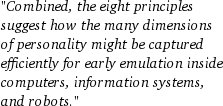Strategies for Personality Transfer
William Sims Bainbridge
page 13 of 15
A person whose self-image emphasizes deeds, will want the same lines of action continued, whether by an intelligent software agent, robot, or other surrogate capable of acting in the same  manner that the person did. Some religious self-conceptions may be quite compatible with technological personality capture, on the basis that at death the soul will leap to the new home most similar to the original, namely to the technologically-created successor. The weakest form of immortality, being well-remembered by survivors, might emphasize recording autobiographical episodes, beliefs that might offer advice to descendents, and expertise that could be useful to later generations.
manner that the person did. Some religious self-conceptions may be quite compatible with technological personality capture, on the basis that at death the soul will leap to the new home most similar to the original, namely to the technologically-created successor. The weakest form of immortality, being well-remembered by survivors, might emphasize recording autobiographical episodes, beliefs that might offer advice to descendents, and expertise that could be useful to later generations.
7. Employ an iterative process to capture an aspect of personality, emulate it, evaluate the emulation, and use the results to refine the capture. This may seem like a very costly process, but approached properly it need not be. Done well it can lead to more accurate and reliable results, because it builds verification into the capture process. A cheaper approach, if it gives poor results, may not be worth its lesser investment. Iterative methods are a central part of user-centered design and comparable methods in human-computer interaction research and engineering, so there is a solid tradition to build upon. In addition, as noted above, computer technology is developing a range of artificial intelligence agents that act on behalf of the user, which means that they incorporate many of the preferences and other characteristics of the user. Advances in agent technology can be transferred to personality capture and emulation, thus saving development costs.
8. In the light of other criteria, be guided by cost-benefit analysis. The current state of development of personality capture technologies is quite uneven, and it would be a waste of resources to invest too much in the least-developed ones. For example, relatively short segments of digital video of a person’s physical movement should be sufficient to capture habitual posture, gestures, expressions, and other motions needed to create a visually realistic avatar, and at present we do not know how to extract more subtle kinds of information from digital videos. On the other hand, social and behavioral science questionnaires are well developed, cover many dimensions of core personality, and are very cheap. I believe that a combination of methods can capture core personality at an acceptable level of fidelity at the present time, for a dollar cost that could readily be afforded by middle-class members of advanced societies. Some effort from the individual is also required, but that is ethically good, because rich people therefore do not have a great advantage over people with more average wealth. The effort is offset by secondary gains, such as improved self-knowledge, possible personality improvement, and by the fact that the process of archiving oneself may be sufficiently pleasurable that it becomes a common leisure time activity.
Conclusion
Combined, the eight principles suggest how the many dimensions of personality might be captured efficiently for early emulation inside computers, information systems, and robots. Concretely, we can imagine an organization to manage the process, whether set up as a for-profit corporation, a professional service, or a non-profit cooperative. Call it the Center for Personality Transfer. A person would sign up for a series of services and to have the Center manage multiple, secure copies of the individual’s archive. In the long run, the plan would be to send copies to the stars.